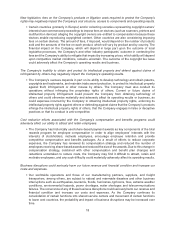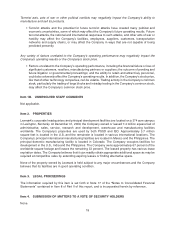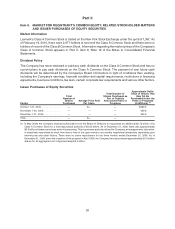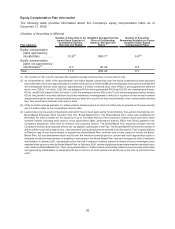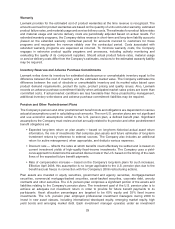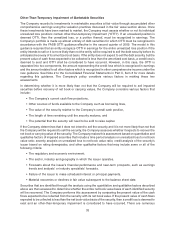Lexmark 2009 Annual Report Download - page 31
Download and view the complete annual report
Please find page 31 of the 2009 Lexmark annual report below. You can navigate through the pages in the report by either clicking on the pages listed below, or by using the keyword search tool below to find specific information within the annual report.could result in lower OEM inkjet and laser supplies demand. However, during 2009 the Company
introduced or continued the introduction of a wide array of new hardware products in both its
segments. Beginning in the fall of 2008 and continuing through the end of 2009, the Company has
announced products that represent the most extensive series of laser product introductions in the
Company’s history. The new product introductions have significantly strengthened the breadth and
depth of the Company’s workgroup laser line, color laser line and laser MFPs. In September 2009, the
Company introduced a new family of inkjet all-in-ones (including new Web-connected touch screen AIOs).
This included four products in the Lexmark Professional Series, targeted for small and medium
businesses. In 2009, the Company also experienced an improvement in the Company’s retail
presence in U.S. Office Super Stores. The Company continues to invest in its core print technologies
and product development in order to generate new Lexmark products.
Refer to the section entitled “RESULTS OF OPERATIONS” that follows for a further discussion of the
Company’s results of operations.
Trends and Opportunities
Lexmark management believes that the total distributed output opportunity was between $80 and
$90 billion in 2009, including hardware and supplies. This opportunity includes printers and
multifunction devices as well as a declining base of copiers and fax machines that are increasingly
being integrated into multifunction devices. Based on industry information, Lexmark management believes
that the market declined in 2009 due to the continued global economic weakness. When global economic
growth resumes, the industry could again experience low to mid-single digit annual revenue growth rates
with highest growth likely to be in MFPs, color lasers and related software solutions and services and the
stronger emerging countries.
Market trends driving long-term growth include:
• Increased adoption of color and graphics output in business;
• Advancements in electronic movement of information, driving more pages to be printed by end
users when and where it is convenient to do so;
• Continued convergence in technology between printers, scanners, copiers and fax machines into
single, integrated AIO devices;
• Increasing ability of multi-function devices and all-in-one devices to integrate into process workflow
solutions and electronic content management systems; and
• Advancements in digital photography driving the opportunity to print digital images on distributed
output devices.
As a result of these market trends, Lexmark has growth opportunities in monochrome laser printers, color
lasers, laser MFPs and inkjet AIOs.
Color and multifunction products continue to represent a more significant portion of the laser market. The
Company’s management believes these trends will continue. Industry pricing pressure is partially offset by
the tendency of customers to purchase higher value color and multifunction products and optional paper
handling and finishing features as well as to purchase output through print and document management
software solutions and services that help customers to optimize their document-related infrastructure to
improve productivity and cost.
The inkjet product market historically has been predominantly a consumer market, but there is an
increasing trend toward inkjet products being designed for SOHO and other businesses.
Advancements in inkjet technology are allowing inkjet devices to print at speeds and with document
quality competitive with low-end lasers and meeting business standards. Customers are increasingly
seeking productivity-related features that are found in inkjet multifunction products designed for office use
such as wireless and ethernet connectivity, automatic document feeders and duplex capabilities, as well as
25





